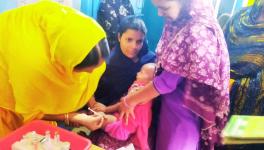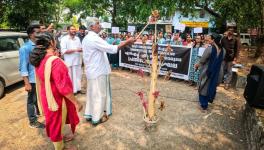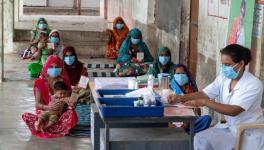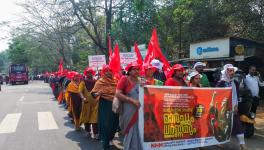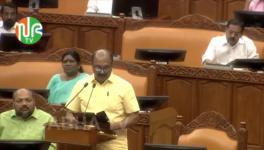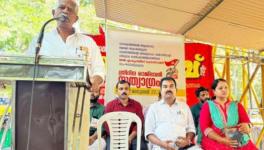Grim Picture of NRHM: Ailing CHCs and Shortage of Doctors
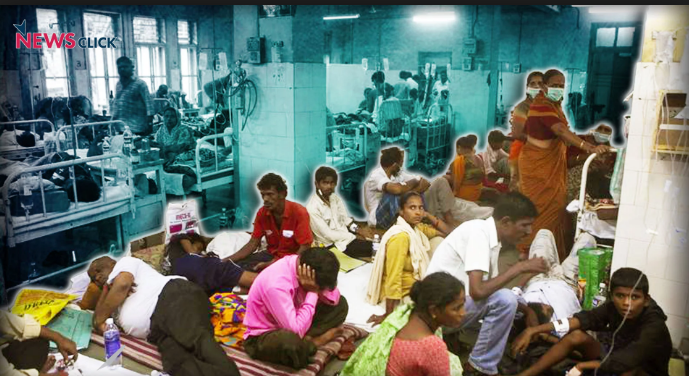
NewsClick analysed the status of National Health Mission in India. This is part 2 of a two-part series. Click here to read part 1.
Even though the National Democratic Alliance government in the Union Budget for FY 2019-2020 increased the allocation for health by 16% to Rs 64,999 crore from the previous year’s revised estimate of Rs 55,949 crore, we are still nowhere close to reaching the National Health Policy commitment of increasing public health spending to 2.5% of the GDP.
Talking to NewsClick, Dr Gargeya Telakapalli of Jan Swasthya Abhiyan said, “The government does not seem to be interested in strengthening the public health systems anymore. Even in areas where healthcare can be provided through Community Health Centres and sub-divisional hospitals, their main focus seems to be on [pushing citizens towards the private sector which is supported by the Pradhan Mantri Jan Arogya Yojana (PMJAY) schemes. This can be seen in the way they have increased the budget for PMJAY by 166% and the budget for the National Health Mission (NHM) by just 8%.”
Whenever the Minister of State for Health and Family Welfare Ashwini Kumar Choubey was asked about various aspects of the NHM in the Parliament, he said that the responsibility lies in the jurisdiction of the different states, even though it is a centrally sponsored scheme.
Community Health Centres
The Community Health Centres (CHCs), which constitute the secondary level of healthcare, were designed to provide referral as well as specialist healthcare to the rural population. A CHC acts as the referral centre for every four Primary Health Centres (PHCs). The National Rural Health Mission (NRHM) envisages that the CHCs should provide all essential services to the rural population, including routine and emergency care in surgery, medicine, obstetrics and gynaecology, dental, and AYUSH. According to Indian Public Health Standards (IPHS), CHCs should also have newborn stabilisation units, facilities for medical termination of pregnancy (MTP) for second trimester pregnancy, Integrated Counselling and Testing Centre (ICTC), blood storage, and Anti-retroviral Therapy centre.
However, if we look at the current state of the CHCs across the country, the IPHS norms not only seem unattainable, but also unrealistic. Currently, there are 5,624 CHCs functioning across the country. In 2005, this number was 3,346, which is to say that there has been an increase of 68% in the number of CHCs. However, if we delve into the data presented in Rural Health Statistics, 2018, most of these CHCs are in shambles.
Even in 2005, in the 3,346 CHCs, there was a huge insufficiency of specialists. The total requirement of specialists (physicians, surgeons, obstetricians and gynaecologists, paediatricians) in 2005 was 13,384, and there was a dearth of 6,110 doctors, which is to say that there was a shortfall of 45.65%. However, when compared to the current crisis, that seems almost acceptable.
In the 5,624 CHCs functioning across the country, there is a requirement of 22,496 specialists. However, the shortage of specialists is a shocking 81.89%, that is, the CHCs across the country lack 18,422 doctors. At 85.72%, the shortfall is the highest for physicians, followed by 84.58% for surgeons, 82.61% for paediatricians, and 74.68% for obstetricians and gynaecologists. The CHCs also have a requirement of 5,624 radiographers, out of which, only 2,128 are in position, causing a shortfall of 64.7%.
It should be noted that even though there is a requirement of 22,496 specialists in the CHCs, the number of sanctioned posts is 13,635, which is only 60.61% of the required amount. The number of AYUSH doctors required at the CHCs as per IPHS norms is 5,624. However, according to the RHS 2018, even though 5,181 doctors are employed – which is more than the sanctioned number 4,694 – there is still a shortfall of 2,448 doctors.
A deeper look into the numbers reveals why this is the scenario. In certain states, like Uttar Pradesh, the number of sanctioned posts for AYUSH doctors is 2,437 against the requirement of 822. As a result, a surplus of 1,615 doctors are working in CHCs across the state while in another state, Rajasthan, the number of sanctioned posts is 128 against the requirement of 588 doctors, and even though there are 133 AYUSH doctors working in the state, there is still a shortfall of 455.
Population served by the National Rural Health Mission
As per IPHS norms, a sub-centre is supposed to serve a population of 3,000-5,000; a PHC is supposed to serve a population of 20,000-30,000 people, and a CHC for a population of 80,000 to 1,20,000.
However, according to RHS, the average population served per sub-centre in the country is 5,263. The number is 32,387 for PHCs, and 1,48,248 for CHCs. In 10 states and two union territories across the country, the population served by one sub-centre is more than 5,000. In 11 states across the country, the population served by one PHC is more than 30,000. In Jharkhand, the population covered by one PHC is a strong 84,077. Delhi is a close second, with one PHC covering a population of 83,808.
There are 12 states and one UT where the population served by each CHC is more than 1,20,000. As per the RHS data, the situation is worst in Bihar, where one CHC covers a huge population of 6,15,610.
As of March 2018, the average rural area covered by a sub-centre was 18.64 sq. km, and the area was 114.73 sq. km for PHCs. For CHCs, the average area was 525.17 sq. km. For states with hilly terrains, like Sikkim, Mizoram, and Jammu and Kashmir, the area covered by one CHC is more than 2,500 sq. km. This data shows that the citizens in the rural areas have to cover a large distance to access the basic healthcare where they might not even get proper care, owing to lack of staff and infrastructure.
Also read: Increase in Budget Allocation for Healthcare Not Enough
Get the latest reports & analysis with people's perspective on Protests, movements & deep analytical videos, discussions of the current affairs in your Telegram app. Subscribe to NewsClick's Telegram channel & get Real-Time updates on stories, as they get published on our website.










